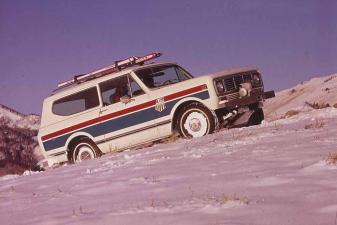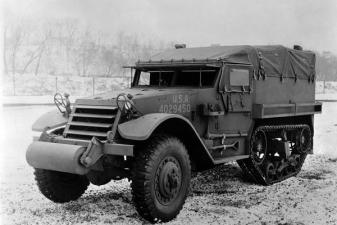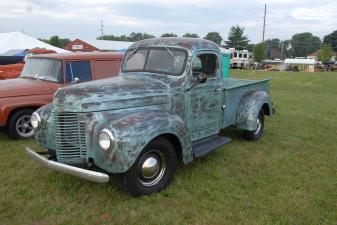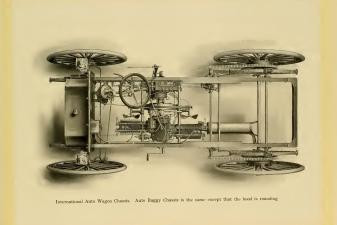The Lost Scout Patriots
A Nerdy Look at a Rare Scout Special

A note from the author: It's a well-known phenomenon that when you produce an historical account of an automobile not well represented in other books, it will unlock floodgates to new information. That certainly proved true when International Scout Encyclopedia was published in 2016. The authors were positively drenched with new information on every level of the International Scout continuum. Among the many tidbits was new information on the 1976 Patriot special editions.
Read the original chapter from International Scout Encyclopedia with further information about this special edition.
The Patriot was one of three Bicentennial-themed special edition Scouts for 1976. They were inspired by the 17 special Scouts supplied to U.S. Olympic Ski Team for the 1976 Winter Olympics at Innsbruck, Austria, February 4-15, 1976. Built in September of 1975 and soon delivered to the Ski Teams practicing here and in Europe, the Ski Team Scouts had a special red, white and blue themed color scheme that was truly a knockout.The first appearance of the Patriot appliqué came in December of 1975 with the construction of 17 U.S. Olympic Ski Team Scouts. Seven were standard wheelbase Scout IIs. Besides the Ski Team decal and the winch, it was essentially a SnoStar/Patriot. Strangely, no period advertising images of actual Patriots have been found. The Ski Team was also given 10 Travelers, like one one above. The Traveler version of the Patriot/SnoStar was virtually identical. Of the six known SnoStars built, two were Travelers, so other than the Warn winch bumper and Ski Team decal, this represents what a SnoStar Traveler would have looked like.
The Ski Team Scouts certainly got International into the international spotlight. They capitalized on that by announcing three Scout promotional specials in a release dated January 22, 1976. All used the same red and blue appliqué over Winter White paint as the Ski Team Scouts. The Spirit of '76 was the most numerous and elaborate of them, featuring an array of unique options, including a soft top and roll bar. The Patriot and SnoStar were more standard hardtop models and largely identical except that the SnoStar had a ski rack.
The January 22 announcement stated all three models would be delivered to dealers for an Olympic Ski Team-themed sales promotion during February and March. Typically, the production of specials would begin well before the promotion given the travel time needed to get them to dealers or shows. And that was apparently the case but what has the Scout community stumped is the first Line Setting Tickets (LST, A.K.A. build sheets) to be marked with the component code for the appliqué didn't come until early March. Starting in March, all three models were clearly marked with the component code for the appliqué, 10876, what became known as the Spirit or Patriot appliqué. In writing the book, we came across anecdotal evidence of Patriots coming out early without the code on the LST but couldn't confirm how they came to be. Lately there has been a lot of controversy over these Scouts, typically when they come up for sale.
Co-author John Glancy is well known for doing appraisals on Scouts as part of his business at Scout Light Line/Super Scout Specialists. He's run into these Scouts and they pose a little difficulty in delivering an accurate appraisal. Is it a dealer installed accessory or a factory build? When it comes to applying market value and calculating the additional value a particular set of options may add, the appraiser needs to know the "nature of the beast." When that nature is unclear, a good appraiser is hesitant.
ANATOMY OF A PATRIOT
The original 1976 press release listed the basic options for the Patriot. It was available in all three Scout configurations, the 100-inch wheelbase Traveltop, 118-inch wheelbase Traveler (full length top) and the 118-inch wheelbase Terra (pickup). The release specified a body in Winter White (paint code 9219), the Spirit appliqué (10876), Wedgewood Blue interior (16872) and folding rear seat (16915). The press release does not specify any other requirements, though to get the blue interior either the Deluxe or Custom trim level had to be ordered and both included the rear seat in the package. One Patriot LST has been found with a standard Tanbark interior. The known Patriots are a mix of bench (16916) or bucket (16709) front seats, Deluxe (16828) or Custom (16834) trim levels. All but a few have the Deluxe Exterior (16835). Many have the luggage rack (16903). Any powertrain was possible and all the à la carte options not in a package were possible.
Of the documented Patriots, a bit more than half are 100-inch wheelbase Traveltops and the rest are Travelers. No documentary evidence exists of Patriot Terras, but at least one ex-IH employee remembers running into paperwork on one. Our best guess is that it was an early production unit before the 10876 code was used on the LST.
THE DOCUMENTED
The first known documented Patriot was FGD33989 built March 19, 1976. "Documented" indicates it has the 10876 Spirit appliqué code (alternatively listed as Patriot appliqué) on the LST. Most often, the LST will also have a handwritten "Patriot" in the ship-to box at the top. The Spirit of '76 models came a bit earlier, the first one coming March 5, 1976, as VIN FGD33458. These numbers come from a combination of searches through the LST files at the Wisconsin Historical Society and the Service Microfiche records. We have not found or heard of any undocumented Spirit of '76 models.
As of this writing, we have found 45 documented Patriots and six SnoStars, a total of 51. Of those, 19 are long wheelbase Travelers and 32 are standard wheelbase Traveltops. The first (FGD33989) was built March 19, 1976 and the last June 10, 1976 (FGD44368).
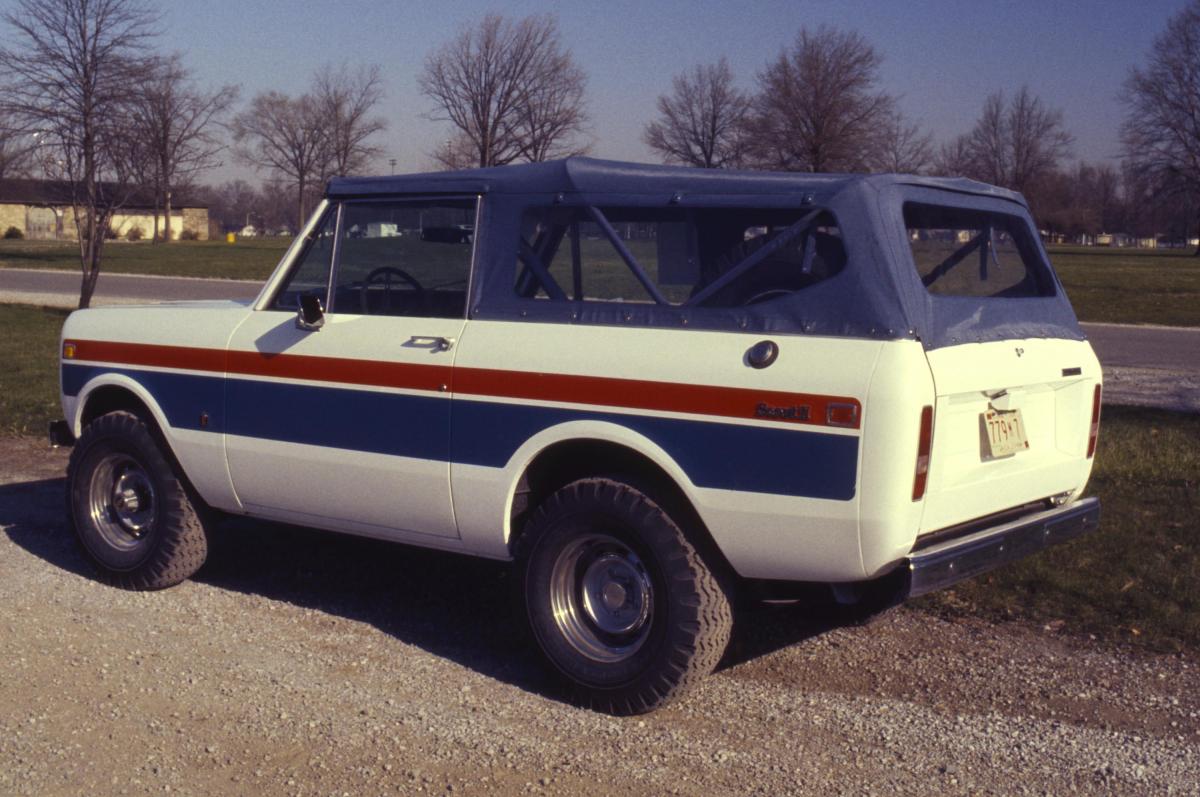 The Spirit of '76 was the largest departure from the Scout II norm. Besides the Whitco soft top and roll bar, it had a Sport Steering wheel and chrome reverse "Rallye" wheels with 10-15 Goodyear Tracker Tires. They shared the Winter White paint and 10876 appliqué with the Patriot, as well as the Wedgewood Blue interior but only the Deluxe Interior was available, not the Custom, due to the soft top. Bench or bucket seats were available. The standard exterior was specified with the addition only of the chrome grille insert., so they did not have body side mouldings (with a couple of exceptions). Any powertrain was available. John Glancy
The Spirit of '76 was the largest departure from the Scout II norm. Besides the Whitco soft top and roll bar, it had a Sport Steering wheel and chrome reverse "Rallye" wheels with 10-15 Goodyear Tracker Tires. They shared the Winter White paint and 10876 appliqué with the Patriot, as well as the Wedgewood Blue interior but only the Deluxe Interior was available, not the Custom, due to the soft top. Bench or bucket seats were available. The standard exterior was specified with the addition only of the chrome grille insert., so they did not have body side mouldings (with a couple of exceptions). Any powertrain was available. John Glancy
THE UNDOCUMENTED
Not long after Scout Encyclopedia was first published, what appeared to be an original Patriot was presented for our attention. It had what appeared to be a period appliqué on a Scout that met all the other criteria, Winter White Traveltop with a Wedgewood Blue interior. Problem was the 10876 code was not on the LST. Then another one showed up, and another and then more. The earliest one to turn up was FGD27976 built January 28, 1976. Most of these pass a visual test that indicates an appliqué installed early in the Scout's life, if not at birth. In one case, we have seen a low-res copy of the dealer invoice. As best as can be determined, there is no mention of Patriot on it–though this requires more study if or when a higher res copy of the invoice is made available for study. Finding a dealer invoice with the Patriot appliqué listed would certainly add validity.
The feature all undocumented Patriot have in common is that they were shipped to the Truck Sales Processing Center (TSPC) in Fort Wayne before being shipped to the dealer. The earliest known is the previously mentioned Patriot Traveler from January 28, 1976, and the latest known built February 26, 1976, not long before the first Spirit (all Spirits were documented). The most obvious answer is that Patriots would be needed rapidly ahead of the upcoming promotions, so they circumvented the usual methods and got the appliqué installed at TSPC rather than on the assembly line. It's interesting to note that some documented Patriots also went to TSPC.
The TSPC were facilities operated by the Sales Department of International for installing accessories, fleet and special equipment that couldn't be installed on the assembly line. There were several around the country, including just down the road from the Fort Wayne Scout and Truck plants. They had a separate budget and paperwork from the manufacturing side and that paperwork has been difficult to source. Most often, if an LST was generated for an ordered vehicle, all the desired features were listed on the LST, even if some were beyond the scope of the assembly line. The ship-to information indicated a trip to TSPC and those items would then be installed. There has been enough anecdotal information over the years of some Scouts going to TSPC for installation of various accessories were not documented in this way, including the Patriots. There is no doubt a separate paper trail for these existed but did it survive the years and where the hell is it today?
Another common theory is that the stripes were installed by dealers. Given the difficulty of installing them properly, it's not a strong theory but possible. We know that did happen at later periods with other appliqués at a few select dealers. One former International dealer, who sold one of the undocumented Patriots, was interviewed and shed a lot of doubt on this, saying that was a job his dealership would not have undertaken and doubted many would have. One interview from one ex dealer is not necessarily conclusive, but it's a useful data point. We are trying to verify if they ever appeared in the parts book and if so which edition. We have been told they were for a limited time but have yet to find the correct editions of the parts book.
As of this writing there are seven Scouts that have surfaced with what appear to be period genuine appliqué, meet the other criteria and went to TSPC. There are reports of more that have not been verified. For now, we can state the undocumented Patriots were built between January 28 and March 19, 1976, between VIN FGD27976 and FGD32738. Most likely there were more beyond both ends of the known VIN and date ranges. Beyond the unlikely possibility records might be found, we will see what can be figured out from the surviving undocumented rigs and hopefully more dealer paperwork.
 Here is the best side of an undocumented Patriot, which now belongs to Michael Rubinstein. It was originally a California Scout and built February 26, 1976, late in the run of the undocumented Patriots. The original selling dealer is still in business and the man who sold this Scout is still there. Eric Lieuwen
Here is the best side of an undocumented Patriot, which now belongs to Michael Rubinstein. It was originally a California Scout and built February 26, 1976, late in the run of the undocumented Patriots. The original selling dealer is still in business and the man who sold this Scout is still there. Eric Lieuwen
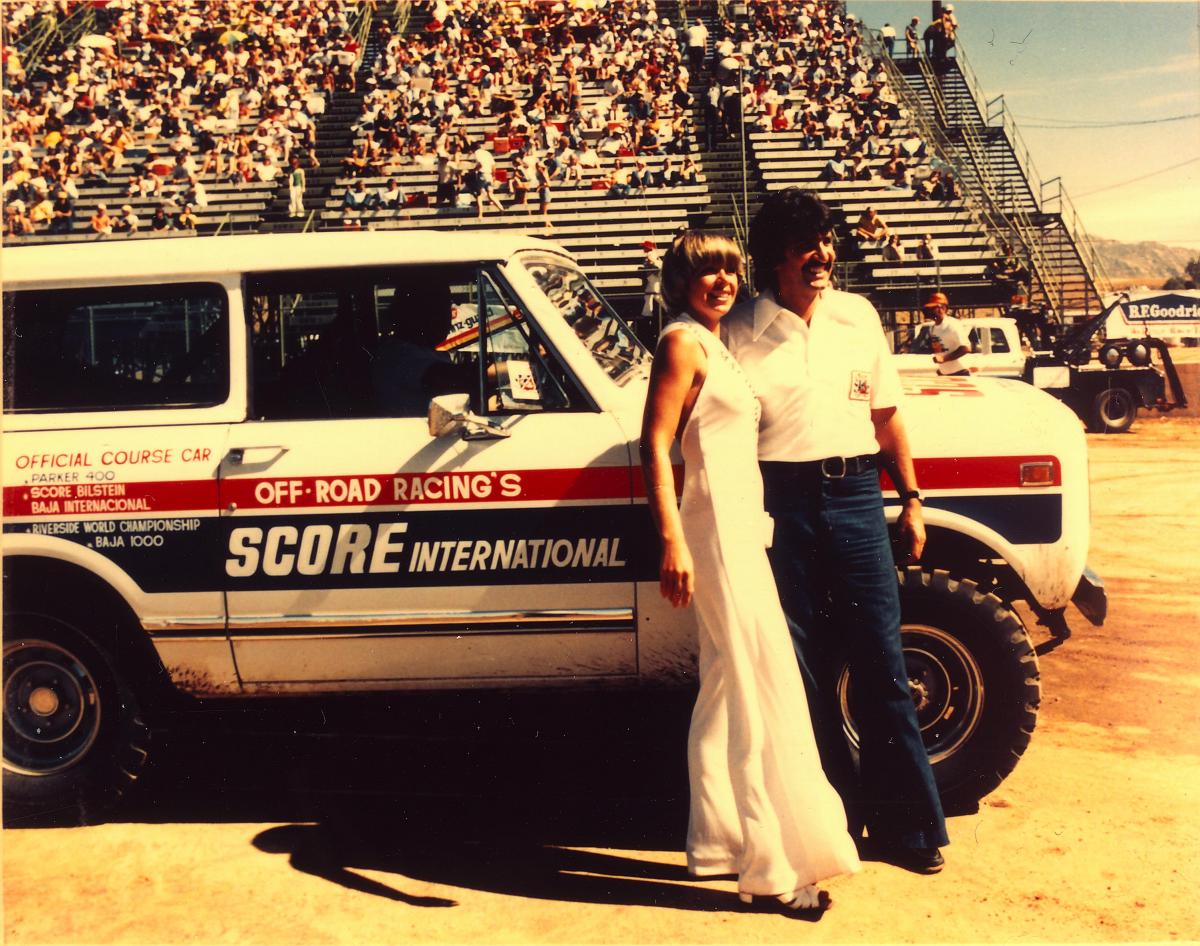 International provided both Patriots and Spirits to SCORE for the 1976 Parker 400 race, held February 5-7, 1976. Given the dates of the event, this Patriot has to have been an undocumented unit. The Patriot is mounting the Rallye wheels and Goodyear Tracker tires used on the Spirit. This was an à la carte option for Patriots, though in the run of documented Patriots, only one was so-ordered. On the right is Sal Fish, who was still very new to the job of running SCORE International, one of desert racing's main sanctioning bodies. The lady to his right looks a lot like Barbara Fish, his wife. Sal expertly ran SCORE for 40 years before retiring in 2012. John Glancy
International provided both Patriots and Spirits to SCORE for the 1976 Parker 400 race, held February 5-7, 1976. Given the dates of the event, this Patriot has to have been an undocumented unit. The Patriot is mounting the Rallye wheels and Goodyear Tracker tires used on the Spirit. This was an à la carte option for Patriots, though in the run of documented Patriots, only one was so-ordered. On the right is Sal Fish, who was still very new to the job of running SCORE International, one of desert racing's main sanctioning bodies. The lady to his right looks a lot like Barbara Fish, his wife. Sal expertly ran SCORE for 40 years before retiring in 2012. John Glancy
ATTENTION SCOUT AFICIONADOS!
The second edition of the International Scout Encyclopedia is coming in 2020! Join our mailing list to pre-order and receive special offers!
For more Scout tidbits that did not make it into the book, visit The Lost Chapters series:
Part 1: Auto Buggy & Wagon
Part 2: IHC Slope Hood 1915-1923
Part 3: IHC S-Line 1921-1929
Part 4: IHC A-Line 1930-1935
Part 5: IHC C-Line 1934-1936
Part 6: IHC D-Line 1937-1940
Part 7: IHC K&KB Lines 1940-1949
Part 8: IHC At War
Part 9: IHC L-Line 1950-1952
Part 10: IHC R-Line 1953-1955
Part 11: IHC S-Line 1955-1957
Part 12: IHC A-Line 1957-1958
Part 13: The Scout is Born
Read the original chapter from International Scout Encyclopedia with further information about this special edition.
The Patriot was one of three Bicentennial-themed special edition Scouts for 1976. They were inspired by the 17 special Scouts supplied to U.S. Olympic Ski Team for the 1976 Winter Olympics at Innsbruck, Austria, February 4-15, 1976. Built in September of 1975 and soon delivered to the Ski Teams practicing here and in Europe, the Ski Team Scouts had a special red, white and blue themed color scheme that was truly a knockout.The first appearance of the Patriot appliqué came in December of 1975 with the construction of 17 U.S. Olympic Ski Team Scouts. Seven were standard wheelbase Scout IIs. Besides the Ski Team decal and the winch, it was essentially a SnoStar/Patriot. Strangely, no period advertising images of actual Patriots have been found. The Ski Team was also given 10 Travelers, like one one above. The Traveler version of the Patriot/SnoStar was virtually identical. Of the six known SnoStars built, two were Travelers, so other than the Warn winch bumper and Ski Team decal, this represents what a SnoStar Traveler would have looked like.
The Ski Team Scouts certainly got International into the international spotlight. They capitalized on that by announcing three Scout promotional specials in a release dated January 22, 1976. All used the same red and blue appliqué over Winter White paint as the Ski Team Scouts. The Spirit of '76 was the most numerous and elaborate of them, featuring an array of unique options, including a soft top and roll bar. The Patriot and SnoStar were more standard hardtop models and largely identical except that the SnoStar had a ski rack.
The January 22 announcement stated all three models would be delivered to dealers for an Olympic Ski Team-themed sales promotion during February and March. Typically, the production of specials would begin well before the promotion given the travel time needed to get them to dealers or shows. And that was apparently the case but what has the Scout community stumped is the first Line Setting Tickets (LST, A.K.A. build sheets) to be marked with the component code for the appliqué didn't come until early March. Starting in March, all three models were clearly marked with the component code for the appliqué, 10876, what became known as the Spirit or Patriot appliqué. In writing the book, we came across anecdotal evidence of Patriots coming out early without the code on the LST but couldn't confirm how they came to be. Lately there has been a lot of controversy over these Scouts, typically when they come up for sale.
Co-author John Glancy is well known for doing appraisals on Scouts as part of his business at Scout Light Line/Super Scout Specialists. He's run into these Scouts and they pose a little difficulty in delivering an accurate appraisal. Is it a dealer installed accessory or a factory build? When it comes to applying market value and calculating the additional value a particular set of options may add, the appraiser needs to know the "nature of the beast." When that nature is unclear, a good appraiser is hesitant.
ANATOMY OF A PATRIOT
The original 1976 press release listed the basic options for the Patriot. It was available in all three Scout configurations, the 100-inch wheelbase Traveltop, 118-inch wheelbase Traveler (full length top) and the 118-inch wheelbase Terra (pickup). The release specified a body in Winter White (paint code 9219), the Spirit appliqué (10876), Wedgewood Blue interior (16872) and folding rear seat (16915). The press release does not specify any other requirements, though to get the blue interior either the Deluxe or Custom trim level had to be ordered and both included the rear seat in the package. One Patriot LST has been found with a standard Tanbark interior. The known Patriots are a mix of bench (16916) or bucket (16709) front seats, Deluxe (16828) or Custom (16834) trim levels. All but a few have the Deluxe Exterior (16835). Many have the luggage rack (16903). Any powertrain was possible and all the à la carte options not in a package were possible.
Of the documented Patriots, a bit more than half are 100-inch wheelbase Traveltops and the rest are Travelers. No documentary evidence exists of Patriot Terras, but at least one ex-IH employee remembers running into paperwork on one. Our best guess is that it was an early production unit before the 10876 code was used on the LST.
THE DOCUMENTED
The first known documented Patriot was FGD33989 built March 19, 1976. "Documented" indicates it has the 10876 Spirit appliqué code (alternatively listed as Patriot appliqué) on the LST. Most often, the LST will also have a handwritten "Patriot" in the ship-to box at the top. The Spirit of '76 models came a bit earlier, the first one coming March 5, 1976, as VIN FGD33458. These numbers come from a combination of searches through the LST files at the Wisconsin Historical Society and the Service Microfiche records. We have not found or heard of any undocumented Spirit of '76 models.
As of this writing, we have found 45 documented Patriots and six SnoStars, a total of 51. Of those, 19 are long wheelbase Travelers and 32 are standard wheelbase Traveltops. The first (FGD33989) was built March 19, 1976 and the last June 10, 1976 (FGD44368).
 The Spirit of '76 was the largest departure from the Scout II norm. Besides the Whitco soft top and roll bar, it had a Sport Steering wheel and chrome reverse "Rallye" wheels with 10-15 Goodyear Tracker Tires. They shared the Winter White paint and 10876 appliqué with the Patriot, as well as the Wedgewood Blue interior but only the Deluxe Interior was available, not the Custom, due to the soft top. Bench or bucket seats were available. The standard exterior was specified with the addition only of the chrome grille insert., so they did not have body side mouldings (with a couple of exceptions). Any powertrain was available. John Glancy
The Spirit of '76 was the largest departure from the Scout II norm. Besides the Whitco soft top and roll bar, it had a Sport Steering wheel and chrome reverse "Rallye" wheels with 10-15 Goodyear Tracker Tires. They shared the Winter White paint and 10876 appliqué with the Patriot, as well as the Wedgewood Blue interior but only the Deluxe Interior was available, not the Custom, due to the soft top. Bench or bucket seats were available. The standard exterior was specified with the addition only of the chrome grille insert., so they did not have body side mouldings (with a couple of exceptions). Any powertrain was available. John GlancyTHE UNDOCUMENTED
Not long after Scout Encyclopedia was first published, what appeared to be an original Patriot was presented for our attention. It had what appeared to be a period appliqué on a Scout that met all the other criteria, Winter White Traveltop with a Wedgewood Blue interior. Problem was the 10876 code was not on the LST. Then another one showed up, and another and then more. The earliest one to turn up was FGD27976 built January 28, 1976. Most of these pass a visual test that indicates an appliqué installed early in the Scout's life, if not at birth. In one case, we have seen a low-res copy of the dealer invoice. As best as can be determined, there is no mention of Patriot on it–though this requires more study if or when a higher res copy of the invoice is made available for study. Finding a dealer invoice with the Patriot appliqué listed would certainly add validity.
The feature all undocumented Patriot have in common is that they were shipped to the Truck Sales Processing Center (TSPC) in Fort Wayne before being shipped to the dealer. The earliest known is the previously mentioned Patriot Traveler from January 28, 1976, and the latest known built February 26, 1976, not long before the first Spirit (all Spirits were documented). The most obvious answer is that Patriots would be needed rapidly ahead of the upcoming promotions, so they circumvented the usual methods and got the appliqué installed at TSPC rather than on the assembly line. It's interesting to note that some documented Patriots also went to TSPC.
The TSPC were facilities operated by the Sales Department of International for installing accessories, fleet and special equipment that couldn't be installed on the assembly line. There were several around the country, including just down the road from the Fort Wayne Scout and Truck plants. They had a separate budget and paperwork from the manufacturing side and that paperwork has been difficult to source. Most often, if an LST was generated for an ordered vehicle, all the desired features were listed on the LST, even if some were beyond the scope of the assembly line. The ship-to information indicated a trip to TSPC and those items would then be installed. There has been enough anecdotal information over the years of some Scouts going to TSPC for installation of various accessories were not documented in this way, including the Patriots. There is no doubt a separate paper trail for these existed but did it survive the years and where the hell is it today?
Another common theory is that the stripes were installed by dealers. Given the difficulty of installing them properly, it's not a strong theory but possible. We know that did happen at later periods with other appliqués at a few select dealers. One former International dealer, who sold one of the undocumented Patriots, was interviewed and shed a lot of doubt on this, saying that was a job his dealership would not have undertaken and doubted many would have. One interview from one ex dealer is not necessarily conclusive, but it's a useful data point. We are trying to verify if they ever appeared in the parts book and if so which edition. We have been told they were for a limited time but have yet to find the correct editions of the parts book.
As of this writing there are seven Scouts that have surfaced with what appear to be period genuine appliqué, meet the other criteria and went to TSPC. There are reports of more that have not been verified. For now, we can state the undocumented Patriots were built between January 28 and March 19, 1976, between VIN FGD27976 and FGD32738. Most likely there were more beyond both ends of the known VIN and date ranges. Beyond the unlikely possibility records might be found, we will see what can be figured out from the surviving undocumented rigs and hopefully more dealer paperwork.
 Here is the best side of an undocumented Patriot, which now belongs to Michael Rubinstein. It was originally a California Scout and built February 26, 1976, late in the run of the undocumented Patriots. The original selling dealer is still in business and the man who sold this Scout is still there. Eric Lieuwen
Here is the best side of an undocumented Patriot, which now belongs to Michael Rubinstein. It was originally a California Scout and built February 26, 1976, late in the run of the undocumented Patriots. The original selling dealer is still in business and the man who sold this Scout is still there. Eric Lieuwen International provided both Patriots and Spirits to SCORE for the 1976 Parker 400 race, held February 5-7, 1976. Given the dates of the event, this Patriot has to have been an undocumented unit. The Patriot is mounting the Rallye wheels and Goodyear Tracker tires used on the Spirit. This was an à la carte option for Patriots, though in the run of documented Patriots, only one was so-ordered. On the right is Sal Fish, who was still very new to the job of running SCORE International, one of desert racing's main sanctioning bodies. The lady to his right looks a lot like Barbara Fish, his wife. Sal expertly ran SCORE for 40 years before retiring in 2012. John Glancy
International provided both Patriots and Spirits to SCORE for the 1976 Parker 400 race, held February 5-7, 1976. Given the dates of the event, this Patriot has to have been an undocumented unit. The Patriot is mounting the Rallye wheels and Goodyear Tracker tires used on the Spirit. This was an à la carte option for Patriots, though in the run of documented Patriots, only one was so-ordered. On the right is Sal Fish, who was still very new to the job of running SCORE International, one of desert racing's main sanctioning bodies. The lady to his right looks a lot like Barbara Fish, his wife. Sal expertly ran SCORE for 40 years before retiring in 2012. John GlancyATTENTION SCOUT AFICIONADOS!
The second edition of the International Scout Encyclopedia is coming in 2020! Join our mailing list to pre-order and receive special offers!
For more Scout tidbits that did not make it into the book, visit The Lost Chapters series:
Part 1: Auto Buggy & Wagon
Part 2: IHC Slope Hood 1915-1923
Part 3: IHC S-Line 1921-1929
Part 4: IHC A-Line 1930-1935
Part 5: IHC C-Line 1934-1936
Part 6: IHC D-Line 1937-1940
Part 7: IHC K&KB Lines 1940-1949
Part 8: IHC At War
Part 9: IHC L-Line 1950-1952
Part 10: IHC R-Line 1953-1955
Part 11: IHC S-Line 1955-1957
Part 12: IHC A-Line 1957-1958
Part 13: The Scout is Born


